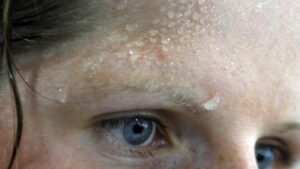Many people have had at least one experience of excessive sweating, perhaps after strenuous exercise or during high stress. For most of us, these events keep coming and going and can only be mildly disturbing. But for about 4.4% of people living in the United States, hyperhidrosis or excessive sweating is a regular occurrence. (1)
Hyperhidrosis is a condition in which sweating is frequent and difficult to control. It is often visible to others, and as such, it can cause anxiety and make you feel self-conscious. (2)
Fortunately, modern medicine offers a number of ways to reduce or prevent excessive sweating. But first, let’s take a look at some of the basics of hyperhidrosis, including its causes and symptoms, and how it is usually diagnosed.
What Are the Different Types of Hyperhidrosis?
There are two different types of hyperhidrosis.
1. Primary focal hyperhidrosis
Primary focal hyperhidrosis is not the result of any other medical condition or medication.
In this scenario, excessive sweating is your diagnosis. Sweating is caused by pollution, affecting both hands and feet or the underarms. This type of hyperhidrosis can start in childhood or adolescence. And for some as a baby gets older, he or she will outgrow this. (3)
2. Secondary general hyperhidrosis
In this case, excessive sweating is either the result of a medical condition or the side effects of medications. This may not start until you are old enough or start taking certain medications. Secondary hyperhidrosis can also cause excessive sweating while you are sleeping. (3)
Medical conditions that can cause secondary hyperhidrosis include: (4)
Gout
Hyperthyroidism
Tumor
Frost byte
Diabetes
Causes and Risk Factors of Hyperhidrosis
Hyperhidrosis, or excessive sweating, is the result of excessive sweat glands. (2)
Sweating is the way the body naturally cools itself and avoids overheating. Your nervous system signals your body to sweat when your body temperature rises, such as when the temperature warms up after exercise, or when you feel anxious or nervous. (2)
How Much Sweating Is Normal?
If you are sweating in any of the above scenarios, and sweating is not affecting your daily life, then you are sweating a small amount.
But in the case of hyperhidrosis, excessive sweating begins without stimuli such as heat and exercise, and you may start sweating even when your body temperature has not risen, marketing for certain dry Jennifer Moore, vice president of the company, explained that antiperspirants can be used to treat people with hyperhidrosis.
Where Hyperhidrosis Occurs
Excessive sweating may occur in different parts of the body, including: (3)
Hand (palmoplanter hyperhidrosis)
Feet (botanical hyperhidrosis)
Face (craniofacial hyperhidrosis)
Axillary hyperhidrosis
Risk factors for hyperhidrosis include a family history of excessive sweating. You may also have hyperhidrosis if you have a medical condition that causes sweating, or if sweating has a side effect of your medication. (2)
Signs and Symptoms of Hyperhidrosis
Excessive sweating is a major symptom of hyperhidrosis. (4)
Tespoora Shane House, MD, a board-certified dermatologist, said: “Sweat can be so intense that armpit sweat can drip onto your arms and body, and there is a risk of your feet slipping on non-carpeted floors. It can be difficult to get around. ” In Santa Monica, California.
Dr. Shane House says that the toes and toes look like branches, just like when you sit for a long time in the bath, and the skin on the feet may be red or white, or it may be itchy or itchy. ۔
Hyperhidrosis Sweating occurs on both sides of the body. (2) So if you are sweating excessively under your right armpit, you will have to sweat excessively under your left armpit.
Sweating associated with hyperhidrosis usually occurs when you are awake and stop when you are asleep. (2)
